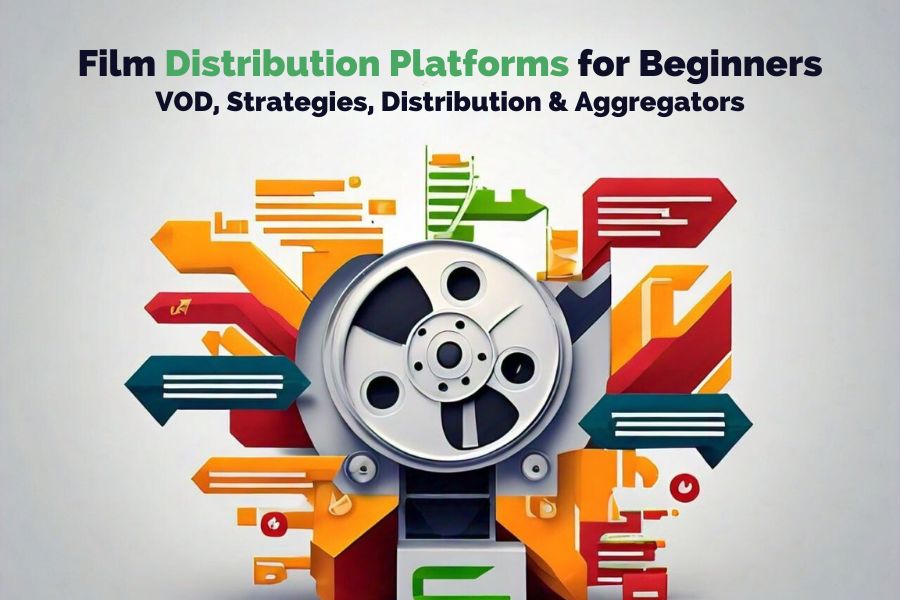Table of Contents
Introduction
Are you an aspiring filmmaker wondering how to get your masterpiece seen by the world? You’re not alone. The journey from completing your film to getting it distributed can be daunting, especially for beginners. But don’t worry; we’ve got you covered. In this article, we’ll explore various film distribution platforms for beginners, including VOD (Video-on-Demand) platforms for filmmakers, film festival distribution strategy, self-distribution for independent films, and film aggregators. Let’s dive in and turn your distribution dreams into reality.
Understanding Film Distribution

What is Film Distribution?
Film distribution is the process of making your film available to the audience. This could be through cinemas, online platforms, DVDs, or TV channels. Essentially, it’s about getting your film seen by as many people as possible.
Traditional vs. Modern Film Distribution
Traditionally, films were distributed through theaters and physical media like DVDs. Today, digital platforms have revolutionized distribution, making it easier for independent filmmakers to reach global audiences without the need for a major studio.
Film Distribution Platforms for Beginners
Definition and Importance
It is important to choose a film distribution platform for beginners. It can determine how widely your film is seen and how successful it becomes. Different platforms have different strengths, so it’s important to understand your options.
Choosing the Right Platform
When selecting a platform, consider your film’s genre, target audience, and budget. Some platforms cater to niche markets, while others have a broader reach. Research each option thoroughly to make an informed decision.
VOD (Video-on-Demand) Platforms for Filmmakers
Overview of VOD Platforms
VOD (Video-on-Demand) platforms for filmmkers allow viewers to watch films on-demand, anytime, and anywhere. These platforms have become incredibly popular due to their convenience and accessibility.
Popular VOD Platforms: Netflix, Amazon Prime, Hulu
Netflix, Amazon Prime, and Hulu are among the top VOD platforms. They have vast audiences and offer significant exposure for films. However, getting your film onto these platforms can be competitive.
Benefits of Using VOD Platforms
VOD platforms provide global reach, flexible viewing times, and potential revenue through subscription fees or pay-per-view models. They also offer analytics to help you understand your audience better.
Challenges with VOD Platforms
While VOD platforms offer many benefits, they also come with challenges. These include high competition, strict submission requirements, and the need for effective marketing to stand out.
Film Festival Distribution Strategy
Importance of Film Festivals
Film festivals distribution Strategy are a fantastic way to showcase your film, gain recognition, and attract distributors. They provide a platform for networking and can be a springboard for your career.
Choosing the Right Festivals
Not all festivals are created equal. Research festivals that align with your film’s genre and audience. Major festivals like Sundance or Cannes offer significant exposure, but smaller festivals can also be valuable.
Submission Tips and Tricks
Submit your film early, follow the submission guidelines meticulously, and tailor your pitch to each festival. Personalize your approach to increase your chances of acceptance.
Maximizing Exposure at Festivals
Once accepted, make the most of the opportunity. Network with industry professionals, engage with the audience, and use social media to promote your screenings. Festivals can be a great launchpad for further distribution.
Network: Festivals are a goldmine for networking. Mingle with industry professionals, attend workshops, and introduce yourself to distributors and critics.
Engage the Audience: Be present at screenings, participate in Q&A sessions, and connect with viewers. Their feedback can be valuable and positive word-of-mouth spreads fast.
Social Media Savvy: Utilize social media to promote your festival screenings, build anticipation, and share updates. Use relevant hashtags and tag the festival to maximize reach.
Self-Distribution for Independent Films
What is Self-Distribution?
Self-distribution for Independent Films means handling your film’s distribution without a traditional distributor’s aid. This approach gives you complete control over your film’s release.
Benefits of Self-Distribution
Self-distribution allows for greater creative control, higher revenue potential, and the ability to build a direct relationship with your audience. You can tailor your marketing strategies to fit your vision.
Steps to Successfully Self-Distribute
- Create a Plan: Outline your distribution strategy, including target platforms and marketing tactics.
- Build a Website: Use it as a central hub for information, sales, and updates.
- Utilize Social Media: Leverage platforms like Facebook, Instagram, and Twitter to reach your audience.
- Engage with Your Audience: Interact with fans, respond to feedback, and build a community around your film.
- Monitor and Adjust: Track your progress and be ready to adjust your strategy as needed.
Real-life Examples of Successful Self-Distribution
Filmmakers like Louis CK and Kevin Smith have successfully self-distributed their films, proving that with the right approach, it’s possible to achieve significant success independently.
Film Aggregators
What are Film Aggregators?
Film aggregators act as intermediaries between filmmakers and distribution platforms. They help get your film onto VOD services, streaming platforms, and digital stores.
How Film Aggregators Work
Aggregators submit your film to various platforms, handle the technical requirements, and ensure your film meets each platform’s standards. They often charge a fee or take a percentage of the revenue.
Pros and Cons of Using Film Aggregators
Pros:
- Wide reach across multiple platforms
- Professional handling of technical aspects
- Saves time and effort
Cons:
- Costly fees or revenue-sharing
- Less control over the distribution process
Popular Film Aggregators: Distribber, Filmhub
Distribber and Filmhub are two well-known aggregators. They offer extensive platform reach and have helped many independent filmmakers get their films distributed widely.
Combining Strategies for Optimal Results
How to Mix VOD, Festivals, and Self-Distribution
Combining different strategies can maximize your film’s exposure and revenue. For example, you can premiere at a film festival, then release on a VOD platform, and finally use self-distribution for long-term sales.
Marketing Your Film
Importance of Marketing in Distribution
Effective marketing is crucial for any distribution strategy. Without it, even the best film can go unnoticed.
Social Media Marketing Tips
Use engaging content, regular updates, and interactive posts to build and maintain interest. Collaborate with influencers and leverage paid ads to reach a broader audience.
Collaborations and Partnerships
Partnering with other filmmakers, brands, or organizations can expand your reach and provide mutual benefits. Look for opportunities to collaborate on marketing efforts.
Financial Considerations
Budgeting for Distribution
Plan your budget carefully, accounting for submission fees, marketing costs, and potential aggregator fees. Be realistic about what you can afford.
Revenue Models and Royalties
Understand the different revenue models available, such as subscription fees, pay-per-view, and ad-supported models. Ensure you know how royalties are calculated and paid.
Managing Costs Effectively
Keep track of all expenses and look for ways to cut costs without compromising quality. Use free or low-cost marketing tools and platforms where possible.
Legal Aspects of Film Distribution
Understanding Distribution Contracts
Always read and understand the terms of any distribution contract. Look for clauses related to rights, revenue sharing, and duration.
Rights Management
Ensure you retain the necessary rights to distribute your film across different platforms and regions. Be clear about what rights you are granting to distributors.
Avoiding Legal Pitfalls
Consult with a legal professional to avoid common legal issues. Protect your film with proper contracts and copyright registrations.
Technological Aspects
Technical Requirements for VOD
Ensure your film meets the technical specifications required by VOD platforms. This includes file formats, resolution, and subtitles.
Ensuring High-Quality Formats
Deliver your film in the highest quality possible. Poor technical quality can detract from the viewing experience and affect your reputation.
Dealing with Piracy
Take steps to protect your film from piracy. This includes using digital rights management (DRM) and monitoring for unauthorized copies online.
Future of Film Distribution

Emerging Trends
Keep an eye on emerging trends like virtual reality, interactive films, and blockchain technology. These innovations could shape the future of distribution.
Impact of Streaming Services
Streaming services continue to grow in popularity, offering new opportunities and challenges for filmmakers. Adapt your strategies to leverage these platforms effectively.
Predictions for the Next Decade
The next decade will likely see further integration of technology in distribution, more direct-to-consumer models, and increased opportunities for independent filmmakers.
Conclusion
Getting your film distributed is no small feat, but with the right strategies, it’s entirely achievable. By understanding the various platforms and approaches, you can make informed decisions that will help your film reach its audience. Whether you choose VOD platforms, film festivals, self-distribution, or film aggregators, each method has its own set of advantages and challenges. Remember, persistence and creativity are key. Happy distributing!
FAQs
1. What is the best film distribution platform for beginners?
The best platform depends on your film and goals. For broad reach, VOD platforms like Amazon Prime are great. For networking and exposure, film festivals are ideal.
2. How can I get my film on Netflix or Amazon Prime?
You can submit through a film aggregator or directly if you meet their requirements. Ensure your film is high quality and marketable.
3. Are film festivals worth the investment?
Yes, festivals can provide significant exposure, networking opportunities, and potential deals with distributors.
4. What are the key challenges of self-distribution?
The main challenges are marketing your film effectively, managing all distribution tasks yourself, and competing with professionally distributed films.
5. How do film aggregators make money?
Aggregators usually charge a fee or take a percentage of the revenue generated by your film on the platforms they distribute to.

